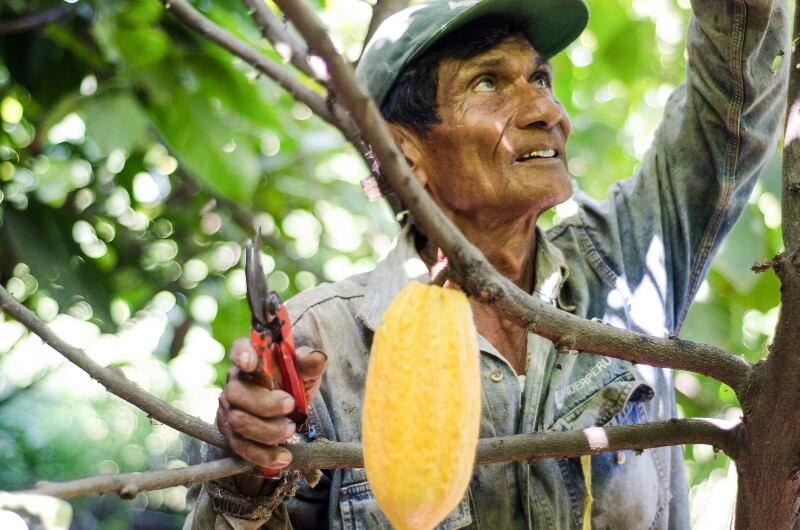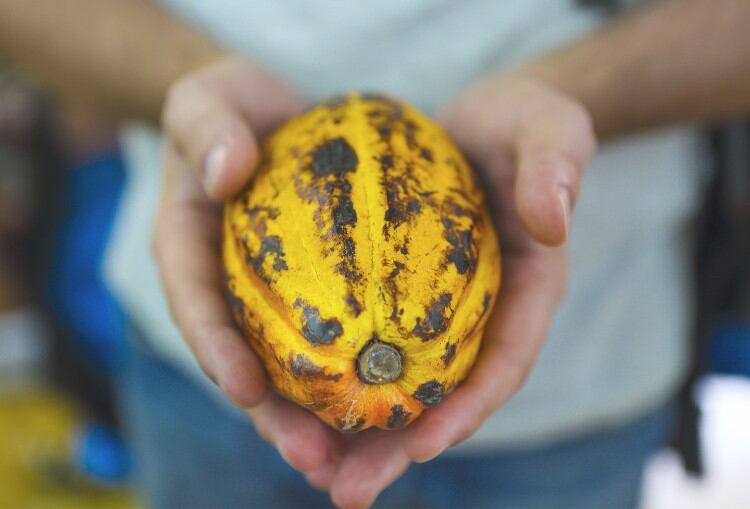The report concludes that cadmium can be found in cocoa and chocolate due to its presence in soils, either through natural or man-made sources, where cocoa is cultivated and harvested in the tropics.
Cocoa plants take up cadmium from soils via their roots and deposit it in the nibs (centre) of cocoa beans. Reducing cadmium levels without compromising taste characteristics will require blending low and high cadmium beans in the short-term, and changes to soil composition or cocoa genetics over time, especially in the Latin America and Caribbean regions where fine flavoured cocoa is grown and cadmium levels in soils tend to be higher.
In contrast, lead is not taken up through the roots of cocoa plants, the experts discovered. Instead, lead from many sources, including soil, dust, and deposition from power plants around the world, adheres to the outer shells of cocoa beans after they are extracted from the pods.
The beans are naturally coated with a sticky cacao pulp known as ‘baba’ or ‘mucilage’ which allows lead to cling to the beans while they are being fermented and dried in the open in the tropical countries where they are grown.
Research found that where feasible, minimising soil contact and the potential for aerial deposition at these stages of the harvesting process, and optimising contaminant removal during subsequent bean cleaning, roasting, and shell removal (as many chocolate manufacturers already do) should help reduce lead levels in finished products.
“The research completed by this expert committee is important in revealing feasible methods of reducing both lead and cadmium in finished chocolate products,” says Danielle Fugere, president and chief counsel at As You Sow.
“We appreciate the collaborative approach of the chocolate industry in funding this three-year study. It shows how California’s Toxic Enforcement Act can lead to positive change. We look forward to working with industry to set lower cadmium and lead levels as we move into the implementation phase of this work.”
Based on their findings, the experts have identified and prioritised a list of recommended cadmium and lead reduction measures for the industry to consider implementing. Significant lead reductions can be expected within the first year of implementing new handling practices. Cadmium reductions beyond those achieved through blending and potential changes in farming practices, including soil treatment and planting new tree stock, will take longer.
Overall, if you compare the cadmium content of even the higher content cocoa beans, the amount found in cocoa and chocolate is significantly lower than in other foods we may consume on a daily basis -- Emily Stone Co-Founder/CEO Uncommon Cacao
Food safety and product quality are the chocolate industry’s highest priorities and the NCA says member companies remain dedicated to upholding high standards and striving for continuous improvement in this regard.
Christopher Gindlesperger, senior vice president of public affairs & communications at the National Confectioners Association, says: “NCA and its members in the chocolate industry welcome the report resulting from the expert committee investigation they funded through a prior California Proposition 65 settlement with As You Sow. We look forward to continuing to work collaboratively to implement feasible measures that assure product quality and safety so that consumers can continue to enjoy chocolate as a delicious treat.”
European legislation
In Europe, the European Commission introduced a regulation in January 2019 setting ‘Maximum Residue Levels’ (MRLs) for cadmium in foodstuffs, including specific cocoa and chocolate products.
Products that are found not to comply with food safety regulations will be denied access to European markets, which is an obvious concern for farmers in South and Central America. Because cadmium can be found in cocoa beans, there are strict regulations being applied to cocoa-derived products (i.e. chocolate). These chocolate limits are being translated to cocoa limits by importers, who are now rejecting cocoa beans that register above the translated thresholds.
Earlier this year, The International Cocoa Organization (ICCO) also announced a major new initiative to address cadmium content in cocoa beans. The project, 'Improving capacity building and knowledge sharing to support management of cadmium levels in cocoa in Latin America and the Caribbean’, will be implemented in Colombia, Ecuador, Peru and Trinidad and Tobago with a budget of $551,000, made possible through a financial contribution from the World Trade Organization (WTO) and the European Union (EU).
“Overall, if you compare the cadmium content of even the higher content cocoa beans, the amount found in cocoa and chocolate is significantly lower than in other foods we may consume on a daily basis, like spinach and shellfish. One would have to consume a very significant amount of chocolate in order for it to pose a risk to their health,'' said Emily Stone Co-Founder/CEO Uncommon Cacao, a sustainable and transparent exporter of beans sourced from Latin America, as well as other regions.
Stone also told ConfectioneryNews that cocoa producers essentially have no control over the cadmium content in their soils. They may be farming land that has been in their family for generations. Many smallholder cocoa producers are 'organic by default,' because their income does not allow them to purchase agrochemical inputs. Cocoa origins with high cadmium content can have extensive areas certified for organic and even biodynamic practices, further assuring us that cadmium in cocoa is naturally occurring.
"There are no commercially viable methods with widespread application at this time for producers who face high-cadmium-content soils," she said. "So, when chocolate makers are no longer able to buy that cocoa due to cadmium regulations, these companies look elsewhere for cocoa, leaving producers without a market and at high risk for a backslide into the volatile commodity cycle or potentially needing to cut down their cocoa trees and replace them with more environmentally damaging monocrops like corn or pineapple."
Governments, scientists, NGOs, cocoa producers, and chocolate companies are racing to identify solutions for reducing cadmium uptake by cocoa trees, but in an already resource-deprived and low-value supply chain, this work is slow and under-funded.
A study* carried out by University of Illinois scientists also discovered that it was the total amount of soil cadmium and pH that explains the amount of cadmium that ends up in a cocoa bean.
The use of lime?
Heavy metal remediation of the soil is not something that the average cocoa farmer can afford but the scientists suggests evidence pointing to lime as a mitigation measure could work to reduce levels of cadmium.
“Liming soils brings down the acidity, making cadmium less soluble and less likely to be taken up by plants,” says assistant professor Andrew Margeno, and one of the scientists involved in the research
Although lime is relatively inexpensive in the US, it’s not cheap in high-poverty contexts, but he believes that lime generally increases the yield for cacao, and because it could have dual benefits, liming could be worth the effort and cost.
“If you're going to ask people to invest in expensive inputs, assuming they can find them, it's nice if they can deliver multiple benefits,” he says.
In their review, the scientists noted studies reporting variation among cacao cultivars in terms of cadmium uptake. Could plant breeding be the answer?
“It's really tough to fight soil chemistry on anything, so breeding cacao varieties or rootstocks that are less susceptible to uptake might be one way out of this. The problem is that most of the world’s fine cacao is grown by small farmers, largely in South America, on maybe 1 or 2 hectares,” Margenot says. “They can't really afford to invest in new germplasm.”
*Drivers of cadmium accumulation in Theobroma cacao L. beans: a quantitative synthesis of soil-plant relationships across the Cacao Belt, is published in PLOS ONE [DOI: 10.1371/journal.pone.0261989].


